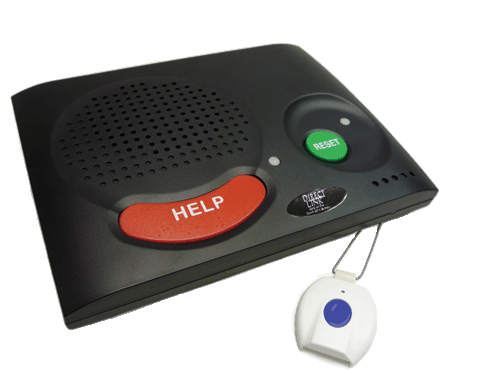In Part 1 of our series on Emergency Alert Units Explained (also know as life lines, life alerts, etc.), we covered the basics of what the units
consist of, and what each piece does. In this part, we'll cover a few of the variations to the basics.
In most cases, when a user presses the 'Help' button on an alert unit, the device calls a monitoring office that will proceed to determine what the true need is. This historically took place over a telephone line. However, with the popularity of cell phones, not all users still have a traditional home phone. Alternatives are 1) Voice Over IP (VOIP) which travels over an internet connection. Providers such as Vonage, AT&T U-verse, Time-Warner Cable, Magic-Jack, or Comcast are examples of VOIP phone providers. For an alert unit to function properly with these requires a special digital unit. The second option is 2) a Cell Based unit which will make the call to the monitoring office over a cell network. By the way, the Cell Based unit operates completely independently of any cell phones or plans that you may have.
It's important that you choose properly here! If a regular phone line is available, then a standard phone emergency alert unit will provide the best reliability at the lowest cost. VOIP compatible devices will be slightly more expensive, and a Cell Based unit typically has the highest cost. However, if there's no home phone of any type, the cell based unit is obviously a good choice. Make certain that there is good cell coverage for the carrier that supports the unit where it will be used. Some rural areas that have sparse cell coverage can be problematic.
Prior to installing a cell unit for any client, our office always performs a search to determine how close the nearest cell tower is to the planned location of use. This assures our customers that a good signal is available and they will receive reliable service. We also test all of our units with the clients during the install to confirm proper operation, regardless of the type, and instruct them to repeat this test on a monthly basis. This will let them confirm ongoing proper operation so that in the event of an emergency, they can be confident that the unit will work!
In Part 3 of this series, we'll discuss features & options that are available with all of our Direct Link emergency alert devices. Many of these features set us apart from all of our competitors! In the meantime, you can view our most popular units by clicking here.
Bringing useful news to educate our clients is one more way that Home Helpers
has been making life easier for over a decade. Call us today at 704-909-7958. And as always, you can find us on our website, Facebook and Google+!
As the premier provider of quality In Home and Senior Care services, Home Helpers has been making life easier for clients for over a decade. We are dedicated to providing exceptional home care services to the greatest of generations... Yours. Call us today at 704-909-7958.
Subscribe to:
Post Comments (Atom)

Thanks for this informative post.Medical Life alert are far more than just a communication device. For seniors, they are a link to the help they may need when they need it most. With the confidence gained from knowing help is available, and possibly some extra support services offered through the systems, many seniors are able to remain in their own homes longer.I would like to read more from here.
ReplyDelete